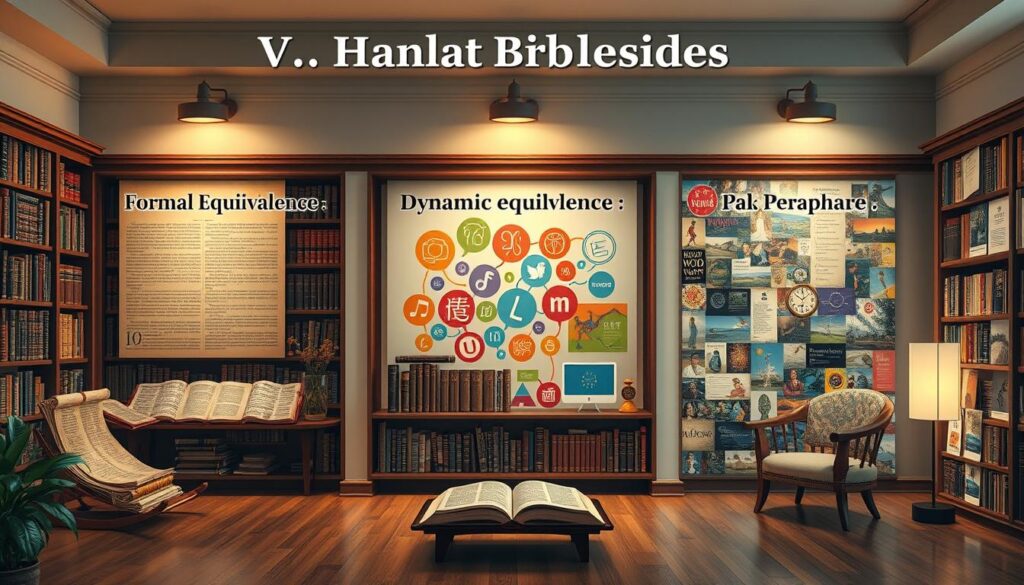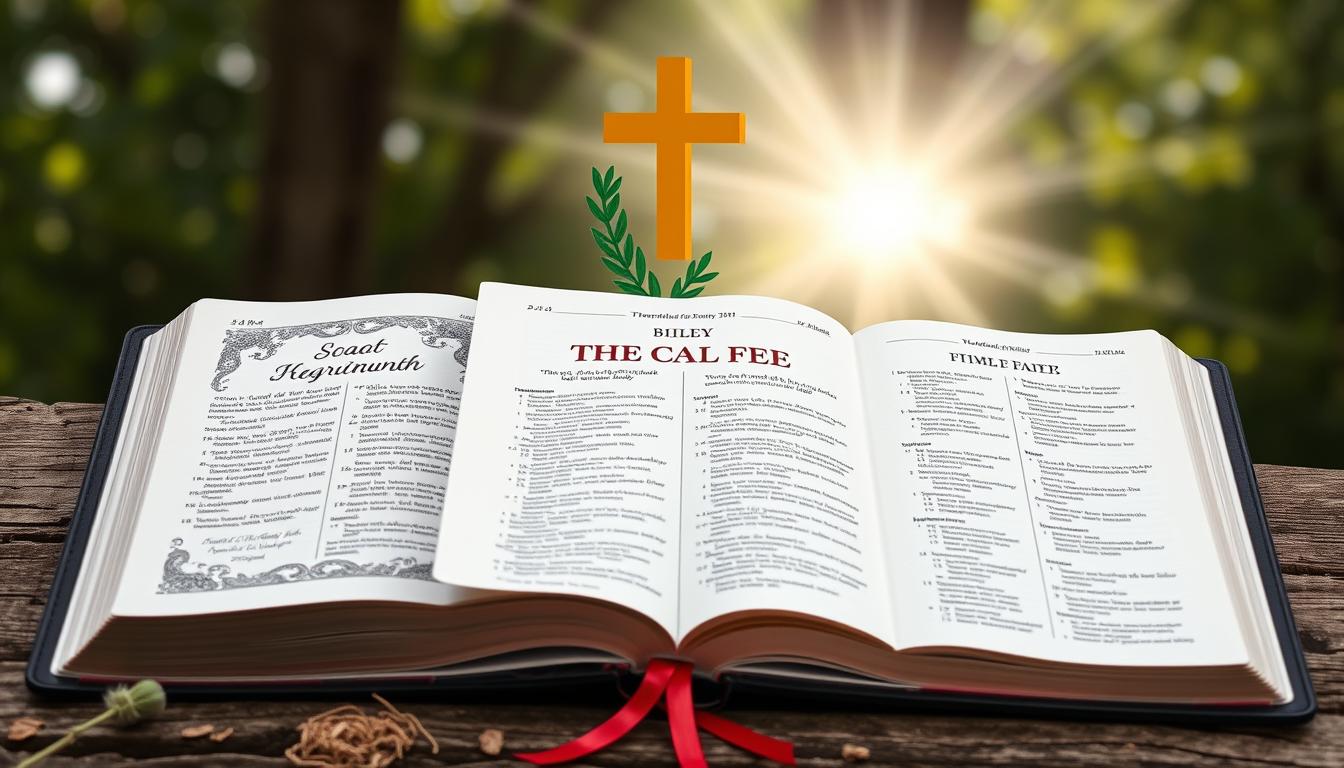Have you ever thought about which Bible translation fits your beliefs and study style best? The Christian Standard Bible (CSB), English Standard Version (ESV), and New International Version (NIV) are top choices in the U.S. Each has its own way of presenting the Bible, aimed at different readers. This article will compare these translations, looking at their accuracy, ease to read, who they’re for, and what scholars say.
Key Takeaways
- The CSB, ESV, and NIV are three of the most popular Bible translations in the U.S.
- Each translation has its own approach to balancing literal accuracy and readability
- Scholars and readers have diverse opinions on the relative strengths of these translations
- Understanding the target audience and intended use is crucial when choosing a Bible translation
- Study Bibles and other resources are available for in-depth exploration of these translations
Introduction to Bible Translations
Bible translations turn the original Hebrew, Aramaic, and Greek texts into languages like English. Translators aim to balance accuracy and readability. Some, like the English Standard Version (ESV), focus on word-for-word translation. Others, like the New International Version (NIV), aim for a more dynamic translation.
Knowing these differences helps us understand the strengths and weaknesses of each version. This knowledge is key to choosing the right Bible for us.
The Christian Standard Bible (CSB) has become very popular, second only to the NIV in sales. It has grown from 10% to 13% of the market in just five years. In 2023, it reached second place on bestseller lists in May, June, and August.
The CSB’s popularity is not just among Southern Baptists. It’s also favored by Anglicans, Presbyterians, Pentecostals, and Foursquare members. Churches like City Church in Cleveland have also switched to the CSB for its clarity.
This shows a trend towards more accessible translations. It highlights the varied needs of Bible readers.
As the Bible translation world evolves, knowing about different philosophies is crucial. This knowledge helps us pick the best version for our needs.

Translation Philosophies
Bible translations fall into two main categories: formal equivalence and dynamic equivalence. Formal equivalence, seen in the King James Version and ESV, aims for a close match to the original words. Dynamic equivalence, found in the NIV, focuses on conveying the overall meaning.
There are also paraphrased versions, like The Living Bible, which make the language easier but raise concerns about accuracy. The ESV was created in 2002 to offer a balance between readability and accuracy.
For beginners, the ESV and CSB are good choices. Experienced readers might prefer the King James or New King James Version for their literal approach. The CSB and New Living Translation are also good for those who want a clear, thought-for-thought translation.
| Translation | Translation Philosophy | Accuracy | Readability |
|---|---|---|---|
| King James Version (KJV) | Formal Equivalence | 98.33% accurate compared to Dead Sea Scrolls | Challenging for modern readers |
| English Standard Version (ESV) | Formal Equivalence | Highly accurate | Balanced between accuracy and readability |
| New International Version (NIV) | Dynamic Equivalence | Accurate but some loss of textual precision | Highly readable |
| Christian Standard Bible (CSB) | Balanced Approach | Accurate with contemporary language | Highly readable |
| The Message | Paraphrase | Concerns over doctrinal soundness | Extremely easy to understand |
In summary, the wide range of Bible translations offers many options. Understanding the different philosophies helps us choose the best version for our needs.
Understanding Translation Philosophies
Bible translations fall into two main types: formal equivalence and dynamic equivalence. Formal equivalence, or literal translation, keeps the original words and grammar, even if it sounds odd in English. Dynamic equivalence, or idiomatic translation, aims to share the original meaning in clear, modern English.
Formal Equivalence
The English Standard Version (ESV) follows the formal equivalence method. It tries to stay close to the original Greek and Hebrew texts. This approach is great for deep Bible study, as it lets readers explore the original language’s details.
The ESV is a slight update of the Revised Standard Version. It keeps the tradition started by the King James Version.
Dynamic Equivalence
The New International Version (NIV) uses dynamic equivalence. It focuses on sharing the original message in easy-to-read English. This makes it popular for personal reading and sharing the faith.
In the last 40 years, the NIV has helped millions find faith in Christ.
The Christian Standard Bible (CSB) tries to find a middle ground. It aims for accuracy while being easy to read in today’s English. This approach is meant for both deep study and personal reading.

“The hope is expressed for the ESV to become the primary reading, preaching, teaching, and memorizing Bible version in the English-speaking world.”
Choosing a Bible translation is complex. It involves many factors like language, culture, and context. Translators must pay close attention to these to accurately translate the original texts into English.
There are many Bible translations out there. They range from word-for-word to thought-for-thought. This variety meets the different needs of readers and churches.
The Christian Standard Bible (CSB)
The Christian Standard Bible (CSB) was first published in 2017. It is a new version of the Holman Christian Standard Bible (HCSB). The HCSB came out in 2004 and was updated in 2009. It was made for the Southern Baptist Convention because of concerns about the New International Version (NIV) royalties and language.
A team of over 100 scholars from 17 denominations worked on the CSB. They included members from the Southern Baptist Convention, Presbyterians, Lutherans, Anglicans, and non-denominational backgrounds. Their goal was to make a translation that is easy to read and accurate, using the “optimal equivalence” method.
Translation Approach
The CSB combines the best of literal and dynamic translation methods. This approach makes the Bible highly accurate and easy to read. It aims to keep the original meaning clear without losing the text’s flow.
In recent years, the CSB has become one of the top six English Bible translations. It is now available in many formats, including portable editions and large-print versions. There are also specialized study Bibles like the CSB Apologetics Study Bible and CSB Ancient Faith Study Bible.
| Bible Translation | Translation Approach | Key Features |
|---|---|---|
| Christian Standard Bible (CSB) | Optimal Equivalence |
|

“The CSB strikes a balance between providing readers with formal renderings of text and functional translations, often including footnotes for further clarity.”
The English Standard Version (ESV)
The English Standard Version (ESV) is a well-respected Bible translation. It focuses on formal equivalence, aiming to keep the original words and structure. This makes it more literal and less natural-sounding than some other versions. Yet, many scholars and readers value it for its fidelity to the original languages.
The ESV is linked to the Reformed theological tradition. It’s a favorite among conservative Evangelical Christians. Its word-for-word approach is why it’s chosen for a precise and accurate Bible text.
Since 2001, the ESV has become very popular. It’s now one of the top English Bible translations, especially among certain Protestant groups. The ESV was updated in 2016 to keep up with new research and discoveries.
“The ESV is a translation that I have used and loved for many years. It combines a faithful, word-for-word approach with a clear and readable style, making it an excellent choice for personal study, teaching, and preaching.”
The ESV’s dedication to formal equivalence and its ties to the Reformed tradition make it appealing. It’s chosen for its highly accurate and theologically-sound nature. Its broad acceptance in Christian circles has made it a leading English Bible version.

The New International Version (NIV)
The New International Version (NIV) is a popular Bible translation. It uses a dynamic equivalence approach. This makes it easy to understand for those new to the Bible or with limited knowledge.
The NIV is known for its clear language. It’s great for personal reading, small group study, and teaching. Unlike strict translations, the NIV uses natural English. This makes it relatable to many people.
Readability and Accessibility
The NIV focuses on being easy to read and understand. Its translators aim for a balance between staying true to the original text and being clear. This means the translation is more about the meaning than exact words.
This approach is a big help for those new to the Bible. The NIV’s simple language helps break down barriers. It’s also available in many formats, like large-print and audio, making it even more accessible.

Even though the NIV isn’t the most literal translation, it’s very popular. It’s great for personal study, group discussions, or teaching. The NIV’s blend of faithfulness and ease of understanding makes it valuable for many.
CSB vs ESV vs NIV: Textual Accuracy
The Christian Standard Bible (CSB), English Standard Version (ESV), and New International Version (NIV) are all very accurate. They stay true to the original Hebrew, Aramaic, and Greek texts.
The ESV is known for being very literal. The NIV focuses on capturing the original meaning in everyday English. The CSB aims for a balance, making it both accurate and easy to read.
These translations are great for deep Bible study and serious theological work. The ESV is best for those who want a precise translation. The NIV is better for those who want something easy to understand.
No English translation can perfectly match the original texts because of language and cultural differences. Using different translations helps readers understand the Bible better. It encourages them to see the depth of the text.
| Translation | Translation Approach | Biblical Accuracy |
|---|---|---|
| CSB | Optimal Equivalence | Highly Accurate |
| ESV | Formal Equivalence (Literal) | Highly Accurate |
| NIV | Dynamic Equivalence | Highly Accurate |
The CSB, ESV, and NIV all aim for accuracy but in different ways. They balance between being very literal and being easy to read. The right translation depends on what you need and how you plan to use the Bible.
CSB vs ESV vs NIV: Readability
Language and Style
The way a Bible is written can change how we read it. The English Standard Version (ESV) is formal and academic. It has harder words and sentences. The New International Version (NIV) is more everyday and easy to get. It uses words we can understand today.
The Christian Standard Bible (CSB) tries to find a middle ground. It uses clear language that sounds natural. At the same time, it keeps the original texts’ meaning. The CSB team made choices to make it easy to read, for everyone from adults to new English learners.
| Bible Translation | Language and Style |
|---|---|
| ESV | More formal and academic, with a slightly more challenging vocabulary and sentence structure. |
| NIV | More conversational and accessible, using language that is easier for modern readers to understand. |
| CSB | Strikes a balance, providing clear and natural-sounding language while preserving the integrity of the original texts. |
Choosing a Bible translation depends on what you need it for. The CSB is great for both personal study and teaching. It’s clear and easy to read, without too much extra information.
“For God so loved the world, that he gave his only begotten Son, that whosoever believeth in him should not perish, but have everlasting life.”
John 3:16 shows how different translations can be. The ESV and NIV stick to traditional words. The CSB uses “one and only Son” instead of “only begotten Son.” These choices help each translation meet its goals of being easy to read and true to the original message.
Target Audiences and Intended Use
Choosing the right Bible translation depends on who you are and how you plan to use it. The Christian Standard Bible (CSB), English Standard Version (ESV), and New International Version (NIV) each serve different readers.
The ESV is popular among those who value a strict word-for-word translation. It’s favored by more conservative and academic readers. On the other hand, the NIV is loved by evangelical Christians. It’s known for being easy to read and understand.
The CSB finds a middle ground between being accurate and easy to read. It appeals to many Evangelical Christians, regardless of their denomination. This makes it great for personal study, group discussions, or public speaking.
Knowing who each translation is for helps readers pick the best one for them. Whether you need a detailed, academic version or something more straightforward, there’s a Bible out there for you.
CSB vs ESV vs NIV
When we compare the Christian Standard Bible (CSB), English Standard Version (ESV), and New International Version (NIV), we see their strengths and weaknesses. The CSB has become one of the top six English Bible translations, thanks to the ECPA’s statistics. Over a hundred scholars from seventeen denominations worked on the CSB and its predecessor, the HCSB. The CSB balances formal and functional renderings, often with footnotes for extra help.
The ESV is known for its word-for-word accuracy, but it can be tough for some readers. It’s more “word-for-word” than the NIV. For example, “Thus” is used 9 times in the CSB but 691 times in the ESV. “Lest” is used 0 times in the CSB but 186 times in the ESV. The ESV and CSB differ in passages like John 5:19 and Proverbs 27:6, affecting how readers understand them.
The NIV focuses on being easy to read but might lose some of the original language’s nuance. The NIV was updated in 2011 to change gender-specific language. The New Living Translation (NLT) is designed to be read at a 6th-grade level, making it very accessible.
Choosing between these translations depends on what the reader needs and prefers. Holman has introduced premium Bibles like the CSB Wide-Margin Verse-by-Verse and the CSB Study Bible. There are many study Bibles in the CSB format, like the CSB Apologetics Study Bible for Students. The CSB website shows that scholars from different denominations worked together, making it inclusive.
| Translation | Translation Philosophy | Readability | Denominational Diversity |
|---|---|---|---|
| CSB | Optimal Equivalence | Balanced approach, with footnotes for clarity | Over 100 scholars from 17 denominations |
| ESV | Formal Equivalence, “word-for-word” | More challenging for some readers | Not specified |
| NIV | Dynamic Equivalence, prioritizes readability | Accessible, 6th-grade reading level | Not specified |
“The CSB aims to be as word-for-word as possible while maintaining clarity in translations, addressing issues present in the HCSB and ESV.”
The CSB’s way of translating tricky phrases like in Job 9:35 makes them easier to understand without losing the original meaning. The church switched from the ESV to the HCSB from late August 2017 to April/May 2018 for better readability. The HCSB took more liberties in translation, making it harder for preachers to explain, as seen in James 5:15.
Study Bible Editions and Resources
The Christian Standard Bible (CSB), English Standard Version (ESV), and New International Version (NIV) have many study Bible editions. These editions help readers understand the Bible better. They include extra context, commentary, and tools to deepen your understanding.
Study Bible Comparisons
The CSB has many popular study Bibles. These include the CSB Apologetics Study Bible for Students, the CSB Ancient Faith Study Bible, and the CSB Spurgeon Study Bible. The ESV also has many study Bibles, like the ESV Study Bible. The NIV offers study Bibles such as the NIV Study Bible.
These study Bibles meet different needs. The ESV Study Bible is great for those who want a detailed look at the Bible. The NIV Cultural Backgrounds Study Bible is perfect for those interested in ancient cultures and archaeology. The CSB Study Bible offers a unique translation, similar to the NLT, NIV, and ESV Study Bibles.
| Study Bible | Translation | Key Features | Target Audience |
|---|---|---|---|
| CSB Apologetics Study Bible for Students | CSB | Apologetics-focused, student-oriented | Students |
| CSB Ancient Faith Study Bible | CSB | Insights into ancient cultures and context | Readers interested in biblical history and archaeology |
| CSB Spurgeon Study Bible | CSB | Insights from the renowned preacher Charles Spurgeon | Readers interested in Christian history and theology |
| ESV Study Bible | ESV | Detailed footnotes and book introductions | College graduates and individuals seeking in-depth analysis |
| NIV Study Bible | NIV | Comprehensive study notes and features | General Christian audience |
| NIV Cultural Backgrounds Study Bible | NIV | Insights into ancient cultures and context | Readers interested in biblical history and archaeology |
These study Bibles have different features for various audiences. They help readers find the best study Bible for their needs and preferences.
Church Adoptions and Popularity
In recent years, the Christian Standard Bible (CSB) has become very popular in churches. It now outsells the English Standard Version (ESV) in the United States. This is because the CSB is both accurate and easy to read. It’s also available in many formats and study resources.
The ESV is still popular, especially in Reformed churches. The New International Version (NIV) is also a favorite among Evangelical Christians.
The CSB’s growing popularity shows it meets a need for a Bible that’s both faithful and easy to understand. As more people find out about it, this trend is likely to keep growing.
| Bible Translation | Popularity Ranking | Copies Distributed |
|---|---|---|
| King James Version (KJV) | 1st | N/A |
| New International Version (NIV) | 2nd | N/A |
| English Standard Version (ESV) | 3rd | Over 100 million |
| Christian Standard Bible (CSB) | Rising in Popularity | N/A |
The table shows the current Bible translation popularity in the United States. The KJV, NIV, and ESV are the leaders. But the CSB’s growing popularity among churches is a big trend. It shows the CSB is meeting the needs of many Evangelical Christians.
“The Christian Standard Bible has seen a significant rise in popularity and adoption among churches, surpassing the ESV and becoming one of the top-selling Bible translations in the United States.”
Scholarly Perspectives and Reviews
The Christian Standard Bible (CSB), English Standard Version (ESV), and New International Version (NIV) have received many scholarly perspectives and Bible translation reviews. The CSB is known for its clear and easy-to-read translation, appealing to many Evangelicals. The ESV is seen as the top choice for those who value formal equivalence, favored by scholars and conservative Evangelicals. The NIV is loved for its clear language, making it great for personal reading and teaching.
Scholars agree that all three translations are accurate and good for deep study. They suggest having at least one from each category and a Septuagint-based Old Testament for more depth. But, they warn against translations like The Message and NLT, as they can show certain theological views.
Different translations show in verses like Ephesians 4:30 and 2 Peter 1:10, where the NIV and NLT have different words. Overall, scholars see the CSB, ESV, and NIV as valuable for deep study. They also stress the need for a balanced study collection.
“The CSB has been praised for its balance of accuracy and readability, as well as its broad appeal across Evangelical denominations.”
| Bible Translation | Price |
|---|---|
| ESV Mocha Bonded Leather | $44.99 |
| NIV Journal the Word | $26.99 |
| CSB Notetaking Bible | $41.24 |
| ESV Men’s Study Bible | $54.99 |
| ESV Archaeology Study Bible | $69.99 |
| NIV Kid’s Visual Study Bible | $34.99 |
| NIV Teen Study Bible | $39.99 |
| NIV Application Study Bible | $38.49 |
The ESV Archaeology Study Bible has over 2,000 study notes and 400 photos. It also has 200 maps, 200 sidebars, 14 articles, and 4 timelines. Study Bibles add valuable insights and context, making them great for deep study.
In summary, the scholarly perspectives and Bible translation reviews on the CSB, ESV, and NIV highlight their accuracy and value for study. The variety of study Bible editions helps readers understand and apply the Bible in different ways.
Choosing the Right Translation
When picking a Bible translation, think about how you plan to use it. Consider your level of biblical knowledge and what you like. The Christian Standard Bible (CSB) is a good pick for those wanting accuracy and easy reading. It finds a middle ground between the detailed English Standard Version (ESV) and the easy-to-read New International Version (NIV).
If you want a translation that closely matches the original texts, the ESV is a top choice. The NIV, however, is known for being easy to understand. It’s great for personal reading, small groups, and teaching.
The best translation is the one you can understand and connect with. Whether you prefer a detailed, literal version or something easier to read, there are many great options. Each one can help deepen your understanding of God’s Word.
| Translation | Approach | Recommended Use |
|---|---|---|
| ESV | Formal Equivalence | Accuracy-focused study and teaching |
| NIV | Dynamic Equivalence | Personal reading and small group use |
| CSB | Optimal Equivalence | Balanced accuracy and readability |
Remember, the best translation is the one that speaks to you. Choose based on your needs and what you like, not just because it’s popular.
Conclusion
The Christian Standard Bible (CSB), English Standard Version (ESV), and New International Version (NIV) are top choices in the U.S. for Bible translation comparison. Each has its own strengths and appeals to different people. The CSB balances between formal and dynamic equivalence, making it a unique choice.
These translations are all accurate and true to the original texts. Yet, the choice depends on personal taste, how you plan to use it, and your translation features needs. The CSB is easy to read and good for many people, including kids and new Christians. The ESV is known for being concise, which might win over scholars. However, the NIV has been criticized for its 2011 version’s more progressive tone.
Knowing the differences helps readers choose the best version for them. Whether you like a formal or dynamic translation, these options meet various needs and reading levels.
FAQ
What are the key differences between the CSB, ESV, and NIV Bible translations?
The CSB, ESV, and NIV have different ways of translating the Bible. The ESV focuses on keeping the original words and meanings. The NIV aims to make the message clear and easy to understand. The CSB tries to find a middle ground between these two approaches.
These translations also cater to different audiences. They vary in how easy they are to read and the views of scholars.
What is the difference between formal equivalence and dynamic equivalence in Bible translations?
Formal equivalence, or literal translation, sticks closely to the original words and structure. This can make the English sound less natural. Dynamic equivalence, or idiomatic translation, focuses on conveying the meaning in a way that sounds natural in today’s language.
How does the Christian Standard Bible (CSB) differ from the ESV and NIV?
The CSB aims to balance clarity and accuracy. It uses a method called “optimal equivalence.” This makes it more approachable than the ESV but more literal than the NIV.
What are the target audiences and intended uses for the CSB, ESV, and NIV?
The ESV is popular among those who value theological depth and academic rigor. The NIV is favored for its clear, easy-to-read style, making it great for church use. The CSB appeals to a wide range of Evangelical Christians, fitting various denominational backgrounds.
How do the CSB, ESV, and NIV compare in terms of textual accuracy and readability?
All three are seen as very accurate and true to the original texts. The ESV is known for its literalness. The NIV is praised for its clarity. The CSB aims to balance these aspects.
What study Bible editions and resources are available for the CSB, ESV, and NIV?
Each translation has many study Bible editions and resources. These include the CSB Apologetics Study Bible for Students, the ESV Study Bible, and the NIV Study Bible. Each has unique features for different audiences.
How have the CSB, ESV, and NIV been received by scholars and churches?
The CSB has gained popularity in churches, becoming a top seller in the U.S. The ESV is closely tied to the Reformed tradition and is highly valued by scholars. The NIV is widely used across many denominations.
How should a reader choose the best Bible translation for their needs?
When picking a Bible translation, consider your use, literacy level, and preferences. The best translation is the one you’ll engage with and understand best. This could be for personal study, group discussions, or teaching.

